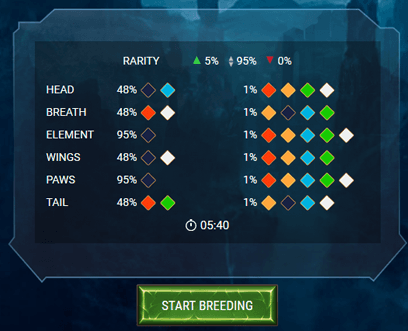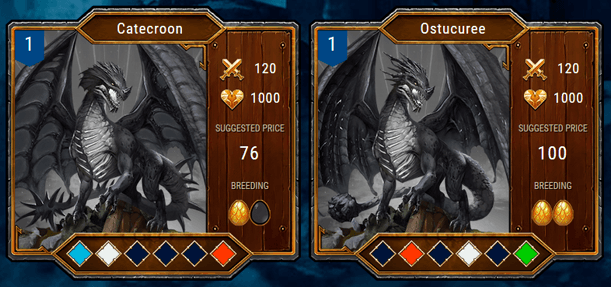How exactly new dragons are made?
Genes are passed to the next generation in the following way:
Same body parts of both parents are part-by-part compared with each other.


If they are from the same set, then there is an 90% chance that the new dragon will receive body part with the same set, and 2% chance for any other set. If they are from different sets, then the new dragon has 40% chance to receive parent#1 set, 48% chance to receive parent#2 set, and 5% chance for any other set.
or example, if parent#1 has head from set#1, and parent#2 has head from set#3, then the new dragon has a 40% chance for head from set#1, 40% chance for head from set#3, and 5% to each of sets left.
If dragons have 4 or more of parts of body are similiar, the chance of hatchling to receive these parts are reduced to 60%, and chance to get another set is increased to 8% each.
During the breeding new dragon’s rarity is defined as average rarity of it’s parents, but it can shift towards higher or lower rarity levels.
| Passing rarity level to new generation | ||||
|---|---|---|---|---|
| weight | save | rise | lower | |
| common | 1 | 99% | 1% | 0% |
| 1.5 | 95% | 5% | 0% | |
| uncommon | 2 | 65% | 12% | 23% |
| 2.5 | 65% | 18% | 17% | |
| rare | 3 | 45% | 9% | 46% |
| 3.5 | 45% | 14% | 42% | |
| epic | 4 | 30% | 6% | 64% |
| 4.5 | 30% | 9% | 61% | |
| legendary | 5 | 10% | 0% | 90% |
Before the start of the breeding, weight of new dragon is calculated as average rarity of parents, i.e (Parent1.Weight + Parent2.Weight)/2. Then according to weight of new dragon his chances to get the rarity are defined.
For example, parent#1 is epic, and parent#2 is rare. Their average weight is defined as (4+3)/2=3.5. According to this weight, new dragon has 45% chance to stay rare, 14% chance to be epic, and 42% chance to be uncommon.
Time consumed for creating new dragon depends on parent’s rarity. It’s calculated based on the following:
| Time of breeding for a one parent | |
|---|---|
| rarity | days |
| Common | 0 |
| Uncommon | 0.5 |
| Rare | 1 |
| Epic | 2 |
| Legendary | 4 |
Time of the breeding process is mostly affected by parents' rarity and their power. The rarer and stronger are parents, the more time they will need to conceive a new hatchling. On the other side players can use their mana potions to skip breeding timer. 1 minute of breeding equals to 1 mana potion.
